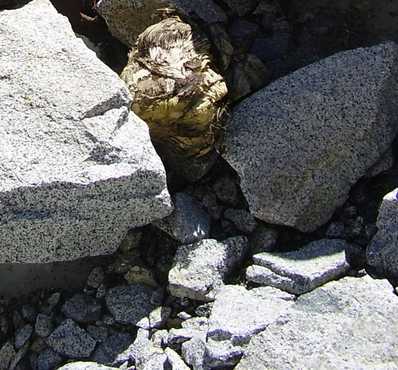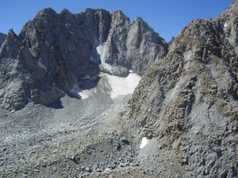-

-
Get in touch
- Call: (800) 877-3400
- E-mail us
- Subscribe
- Customer Service
-
Get in touch
-
News
- Sections
- Columnists
-
Sports
-
Business
- Columnists
-
Life
-
Entertainment
- Calendar
-
Blogs
- Honeycomb
-
Opinion
-
Obits
- Place an Obituary
- Classifieds
-
Cars
- Cars
-
Homes
-
Homes
- Find a Home
- New Homes-North
- New Homes-South Valley
- New Homes
Special Section - Open Homes Directory
- Hot Properties
- List a Hot Property
Online Only - Place a Classified
in Print & Online - Rentals
- Rent an Apartment
- Rent a Home
- List a Rental
on Apartments.com - Place a Classified
in Print & Online - Seniors
- Senior Living
-
Homes
- Jobs
- Shopping
 |
| Special To The Bee |
| The parachute of a World War II-era aviator whose plane crashed
on a glacier at 12,000 feet in the Sierra was discovered at the site.
The body of the aviator is the second recovered from the doomed mission
in the Kings Canyon area. |
Authorities said Monday that a body found on a remote Sierra Nevada mountainside likely is that of a flier who died in a military plane crash 65 years ago.
The body was discovered within 100 feet of where Leo Mustonen, a 22-year-old Army Air Force cadet, was found two years ago, Sequoia and Kings Canyon park ranger Debbie Brenchley said.
Mustonen was aboard an AT-7 aircraft that crashed on a training mission in November 1942.
Peter Stekel, an author writing a book about the crash, discovered the body Wednesday while doing research in the Mt. Mendel area in Kings Canyon National Park, Brenchley said.
Stekel hiked out Thursday and arrived at a ranger station on Friday to report the discovery. Rangers flew by helicopter to the area Saturday to confirm the find, and flew there again Sunday to begin making arrangements to get the remains off the mountain. The body was being brought to the Fresno County Coroner's Office Monday for an initial examination and then will be taken to Hawaii for identification by military officials.
Chief Park Ranger J.D. Swed said there are indications the remains are from the same plane that carried Mustonen, 22, of Brainerd, Minn. He didn't elaborate.
Mustonen was one of four military aviators on an AT-7 training flight from Mather Field in Sacramento that strayed off course on Nov. 18, 1942. A blizzard is believed to have been the cause of the crash on the 13,691-foot Sierra Nevada peak, according to weather reports. The crash site was not known, until two years ago.
When the crash occurred, the training flight was about 200 miles off course.
Others on the flight were: Army cadets John Mortensen, 25, of Moscow, Idaho; Ernest Munn, 23, of St. Clairesville, Ohio; and the pilot, 2nd Lt. William Gamber, 23, of Fayette, Ohio.
Brenchley said the body was found in a rocky area at 12,300 feet of elevation. To get to the area requires hiking more than 25 to 30 miles.
Unlike Mustonen's body, it was not encased in ice. Brenchley said the head, torso and most of the arms were visible.
A parachute was found near the body. It did not appear that the man had tried to open the parachute, she said.
The body was likely hidden by snow when searchers were nearby in 2005, she said. This year's snowpack was only 29% of normal.
Fresno County Coroner David Hadden's office is cooperating with the military's Joint POW-MIA Accounting Command in Hawaii.
In a conference call, the command's deputy scientific director Robert Mann said identification may take several months. Paul Emanovsky, a forensic anthropologist, was flying from Hawaii to recover the body. Emanovsky worked in the 2005 investigation.
The identity of the body will be established through an examination of mitochondrial DNA obtained from family members of those on the 1942 flight, Mann said, since there are no dental records available from the flight members. Hadden said such an effort is beyond the ability of a county coroner's office.
The flight was one of several dozen air crashes during World War II training missions. Many of those aircraft are still missing in the 400-mile long Sierra.
Fresno County Coroner David Hadden said the World War II-era crash appeared to be like many that take place in the Sierra when a plane flies into a bowl-like area and then does not have enough power to pull out.
"It's like driving into a dead end," he said.
Mount Mendel is a remote area well-known by ice climbers. Mendel glacier is about a half-mile wide.
There are about 1,500 small glaciers between Kings Canyon, Sequoia and Yosemite national parks, the southernmost belt of glaciers in the United States.
Scientists say the Sierra glaciers are small and relatively young, about 600 to 800 years old.


 E-mail story
E-mail story Printer friendly page
Printer friendly page Subscribe to Print
Subscribe to Print




